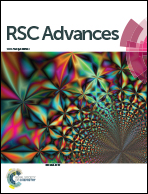A novel green cycle for value-added utilization of waste zinc based adsorbent
Abstract
A novel green cycle for transformation and regeneration of waste zinc based adsorbent was proposed, in which nano CuS/ZnS anode material and nano ZnO with high purity were obtained. The CuS/ZnS@C was used as anode in lithium ion battery with the first discharge capacity 802.7 mA h g−1 and 454.3 mA h g−1 after 38 charge–discharge cycles.


 Please wait while we load your content...
Please wait while we load your content...